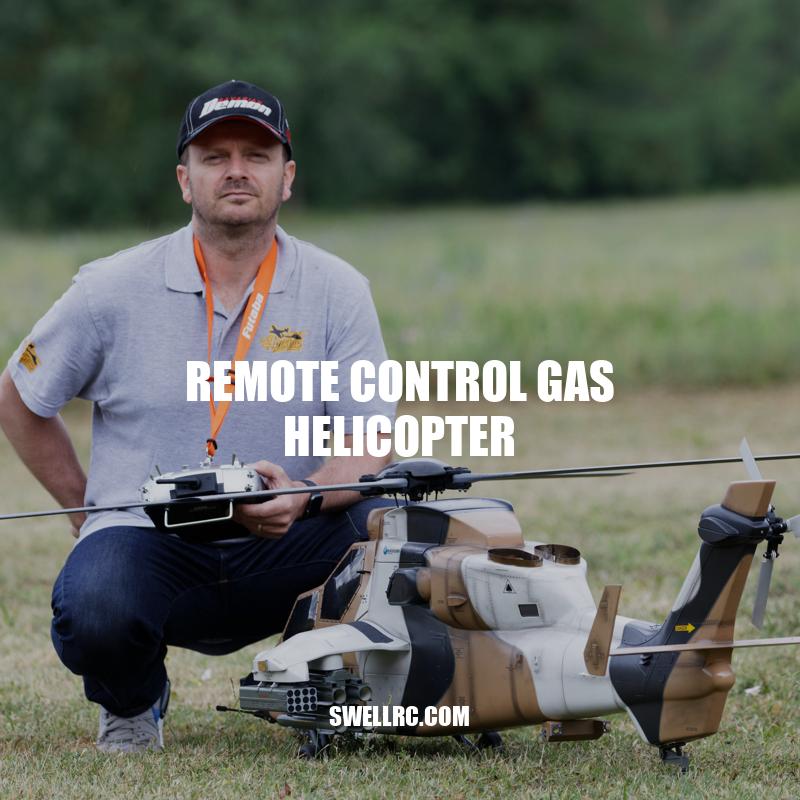Remote Control Gas Helicopters: Features, Types, and Flying Techniques
A remote control gas helicopter is a type of radio-controlled helicopter that uses a gasoline engine to provide lift and flight. Unlike electric-powered helicopters, gas helicopters have a longer flight time, greater power, and a more realistic sound and engine noise. These helicopters are popular among hobbyists and enthusiasts who enjoy the challenge of mastering advanced flight techniques and maneuvers. There are different types of remote control gas helicopters available on the market, including single rotor and dual rotor models, scale models designed to look like real-life helicopters, and military and rescue models used for training and simulations. Flying a gas helicopter requires skill and experience, as it involves understanding basic controls, different flight modes, and safety guidelines. However, the benefits of owning a remote control gas helicopter are many, including the chance to improve hand-eye coordination and spatial awareness, to network with fellow hobbyists, and to potentially pursue a career in aviation or remote control technology. In this article, we will delve deeper into the features, types, and benefits of remote control gas helicopters, and offer some tips on how to fly, maintain, and care for these exciting machines.
Features of remote control gas helicopters
Remote control gas helicopters have a number of features that make them stand out from other types of radio-controlled aircraft. Here are some of the main advantages of choosing a gas helicopter:
- Longer flight time: Gas helicopters can fly for up to 20 minutes or more on a single tank of fuel, compared to electric-powered helicopters which usually have a flight time of around 5-10 minutes. This makes them ideal for longer flights and more advanced maneuvers.
- Greater power and speed: Gas helicopters are powered by a gasoline engine which provides a lot of power and speed, making them suitable for outdoor flights and high-altitude maneuvers.
- Realistic sound and engine noise: The sound of a gas helicopter is more realistic, providing a more immersive experience for users or onlookers.
- Higher cost: Gas helicopters are usually more expensive than electric-powered helicopters, due to the cost of the engine, fuel, and maintenance. However, enthusiasts often find that the benefits outweigh the additional costs.
If you’re interested in purchasing a remote control gas helicopter, there are many websites that offer a wide selection of models for different skill levels and budgets. Popular retailers include Amazon, HobbyZone, and RC Planet. It’s important to do your research and read reviews from other users to find the right helicopter for your needs.
What are the functions of the RC helicopter remote control?
The functions of the remote control (RC) for a helicopter include:
- Controlling the throttle (speed) of the helicopter
- Controlling the pitch of the rotor blades, which controls the altitude
- Controlling the yaw, which controls the direction the helicopter is facing
- Controlling the roll and pitch of the helicopter, which controls its movement horizontally
- Some remotes also have additional functions, such as setting waypoints and controlling cameras
If you are interested in purchasing an RC helicopter and remote control, check out websites like HobbyKing, Blade, and Horizon Hobby for a variety of options.
Types of remote control gas helicopters
There are a variety of different types of remote control gas helicopters available to suit different interests and skill levels. Some of the most popular types include:
Single rotor helicopters
- Traditional design with a main rotor and tail rotor for control.
- Suitable for more experienced users who want to perform advanced stunts and maneuvers.
- Often modeled after real-life helicopters such as the Bell 47 or Robinson R22.
Dual rotor helicopters
- Also known as coaxial helicopters that have two rotors on top of each other.
- Easier to fly and more stable than single rotor helicopters.
- Suitable for beginners or indoor use due to their smaller size.
Scale helicopters
- Modeled after real-life helicopters, these gas-powered helicopters mimic the design and appearance of real-life helicopters from various eras and industries.
- Predominantly for hobby and display purposes.
- Available in a range of sizes from small scale models to larger real flight helicopters.
Military and rescue helicopters
- Used for training purposes and simulations by military and rescue personnel, these gas helicopters are designed to mimic real-life situations and emergency scenarios.
- Available in various designs, from Blackhawk helicopters to rescue choppers used by the Coast Guard.
If you’re interested in purchasing a remote control gas helicopter, it’s important to choose the right type for your interests and skill level. Some popular models include the Blade 230 S V2 BNF gas helicopter, the Thunder Tiger Red Line Raptor G4 E820 gas helicopter, and the Align T-Rex 700XN gas helicopter. However, be sure to do your research and read reviews before making a purchase.
| TYPE | SUITABLE FOR | EXAMPLES |
|---|---|---|
| Single Rotor | Advanced users or hobbyists | Bell 47, Robinson R22 |
| Dual Rotor | Beginners or indoor use | Blade CX2, Align T-Rex |
| Scale Helicopters | Hobby and display purposes | Ecureuil AS355, Bell 429 |
| Military/Rescue | Training and simulations | Blackhawk, Sea Knight |
What is the difference between gas and Nitro RC helicopters?
Gas and Nitro RC helicopters are popular among hobbyists and enthusiasts, but they have some key differences:
- Fuel: Gas helicopters use regular gasoline while Nitro helicopters use a specific type of fuel called nitromethane.
- Power: Nitro helicopters generally have more power and speed due to the nitro fuel, while gas helicopters tend to have better fuel efficiency.
- Maintenance: Gas helicopters are easier to maintain and require less frequent maintenance compared to Nitro helicopters, which need regular tuning and adjustments.
Keep in mind that both types of helicopters have their own pros and cons depending on your needs and preferences. Research more on specific models and featured websites like amainhobbies.com and horizonhobby.com.
How to fly a remote control gas helicopter
Flying a remote control gas helicopter requires practice and patience, but with some basic knowledge and a bit of skill, you can become an expert in no time. Here are some important tips to keep in mind:
Basic Controls
- Throttle – controls the power or speed of the helicopter.
- Pitch – controls the angle of the blades and determines the altitude and direction of the helicopter.
- Yaw – controls the direction of the tail rotor and allows you to rotate the helicopter left and right.
- Roll – controls the lateral balance of the helicopter and allows you to move it forward, backward, left and right.
Trimming and Balance
- Trimming involves adjusting the controls to ensure the helicopter stays level and flies straight.
- Balance is important for stable flight and involves ensuring that the helicopter’s weight is evenly distributed.
- Small adjustments to the controls may be needed to correct any imbalance or drift in flight.
Flight Modes and Techniques
- Helicopters may have different flight modes such as stability mode for easier flight, agility mode for advanced maneuvers, and idle-up mode for faster flight.
- Some techniques to master include hovering, figure 8s, and landings.
- Using head tracking goggles or a first person view (FPV) camera can also enhance your experience and allow for more immersive flight.
Safety Precautions
- Always fly in a safe and open area, away from people and property.
- Ensure the helicopter is always in sight and within a safe distance.
- Read the instruction manual thoroughly and follow all guidelines and safety precautions.
- Wear protective gear such as safety glasses and gloves.
To learn more about flying remote control gas helicopters, you can attend workshops or join forums and communities of other enthusiasts. Some helpful resources include websites such as Horizon Hobby, HeliFreak, and RC Universe.
Are RC helicopters hard to fly?
- RC helicopters can be difficult to fly, especially for beginners.
- They require practice and patience to master.
- There are different types of RC helicopters, each with varying levels of difficulty.
- Selecting a beginner-friendly model can help ease the learning curve.
If you’re interested in purchasing an RC helicopter, it’s important to do your research and find a model that fits your experience level. Websites like HobbyTron.com offer a variety of options for both beginners and more advanced pilots.
Benefits of Owning a Remote Control Gas Helicopter
Owning a remote control gas helicopter can provide hours of entertainment and a range of benefits. Here are some of the main advantages of this exciting hobby:
Engaging and Challenging
- Remote control gas helicopters are an engaging and challenging hobby that can keep you entertained for hours.
- Each flight provides a new challenge and opportunity to improve your skills.
- You can also challenge yourself to complete aerobatic maneuvers and other tricks.
Camaraderie
- Remote control gas helicopters are a popular hobby with a strong community of enthusiasts.
- Getting involved with this community can provide you with valuable knowledge, tips, and advice.
- You can also attend events and competitions to meet other enthusiasts and share your love of this hobby.
Skill Development
- Flying a remote control gas helicopter requires a range of skills, including hand-eye coordination, spatial awareness, and the ability to react quickly to changes in flight.
- These skills can be valuable in other areas of life, such as driving or playing sports.
- Mastering these skills can also give you a sense of accomplishment and confidence.
Career Opportunities
- Developing skills in remote control technology or aviation can lead to career opportunities in fields such as engineering, aviation, or robotics.
- You can also become an instructor or trainer for remote control helicopter enthusiasts.
To start your journey in the exciting world of remote control gas helicopters, you can find a variety of resources and online stores that sell models and parts. Some popular websites include Tower Hobbies, Motion RC, and AMain Hobbies.
Are Helicopters Gas Powered?
Yes, most helicopters are powered by gasoline or aviation fuel. However, some modern helicopters also use diesel or turbine engines.
Notably, electric-powered helicopters are also a developing technology. Although currently rare and mainly used for smaller recreational helicopters, it may become an increasingly popular option in the future due to its lower noise and emissions.
Sources:
Maintenance and Care for Remote Control Gas Helicopters
Performing regular maintenance and care for your remote control gas helicopter is critical to ensure optimal performance and longevity. Here are some tips:
Cleaning and Maintenance
- After each flight, remove any dirt, dust or debris from the helicopter using a soft brush or cloth.
- Inspect the helicopter for any visible signs of damage or wear and replace the parts that are damaged or broken.
- Check for any loose nuts, screws or bolts and tighten them immediately.
- Apply lubricant to all moving parts to ensure smooth operation.
Storage and Transportation
- When not in use, store your helicopter in a cool, dry place, away from direct sunlight or heat sources.
- Keep the helicopter in its original box or a protective case to prevent damage from accidental drops or impacts.
- Use a sturdy, padded bag for transporting your helicopter to prevent any damages that could occur while on the go.
Fuel Selection and Usage
- Use the recommended fuel type for your helicopter and ensure that it’s mixed correctly with the correct ratio of oil and gas.
- Don’t use old fuel, as it can cause engine problems and affects the helicopter’s performance. The fuel should be fresh and ideally used within six months of opening.
- Do not overfill the fuel tank, and avoid overworking the engine during flights.
Troubleshooting
- If you encounter difficulties during flights, consult the helicopter’s manual and follow the appropriate troubleshooting steps.
- Seek assistance from the manufacturer or a professional technician if you’re unable to find the root of the problem.
By following these tips, you can keep your remote control gas helicopter in peak condition, extend its lifespan, and reduce the risk of potentially costly damages or repairs.
What fuel does a RC helicopter use?
RC helicopters can run on different types of fuel, depending on their size, type and design. Here are the most common options:
- Nitro fuel: Nitro-fueled RC helicopters use a mixture of methanol, nitromethane and oil. This type of fuel is mainly used in larger helicopters and provides high power and speed.
- Gasoline: Gas-powered RC helicopters use a mix of gasoline and oil. They are more fuel-efficient and cheaper to run compared to nitro-fueled models.
- Electric: Electric RC helicopters run on lithium polymer (LiPo) batteries. They are quieter, cleaner and easier to maintain than fuel-powered models. They are also suitable for indoor flight and beginners.
Before choosing a fuel for your RC helicopter, make sure to check its owner’s manual for specific recommendations and safety guidelines.
If you are looking for high-quality RC helicopters and related products, check out websites such as Horizon Hobby or Tower Hobbies.
Conclusion
In conclusion, remote control gas helicopters are an exciting and engaging hobby with many benefits to enthusiasts of all ages and experience levels. With their realistic sound and engine noise, longer flight time, and higher power and speed, remote control gas helicopters provide an unmatched experience of flying a real helicopter. While they require more maintenance and have higher fuel costs than other types of remote control helicopters, the rewards of flying a remote control gas helicopter make it all worthwhile.
Maintaining and caring for your remote control gas helicopter is key to maximum performance and longevity. By following the tips listed, you can extend the life of the helicopter and avoid costly repairs.
Whether you are a beginner or an experienced pilot, owning and flying a remote control gas helicopter is an excellent way to improve your coordination and spatial awareness while having fun. So why not give it a try? With many models and styles to choose from, there is something for everyone. Take the plunge and explore this exciting hobby today!



